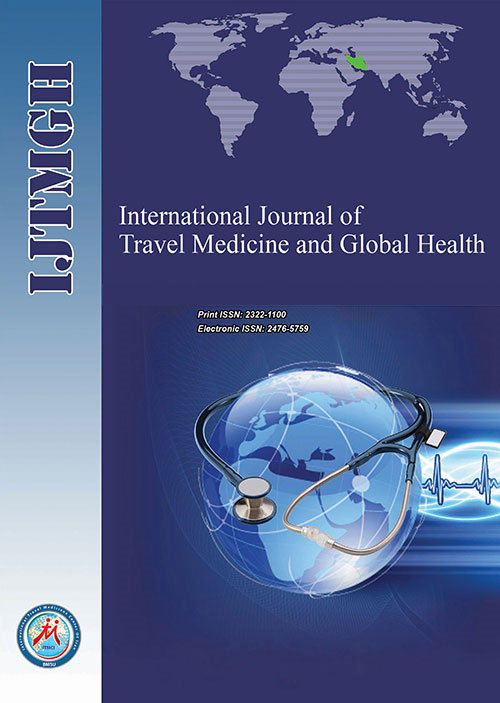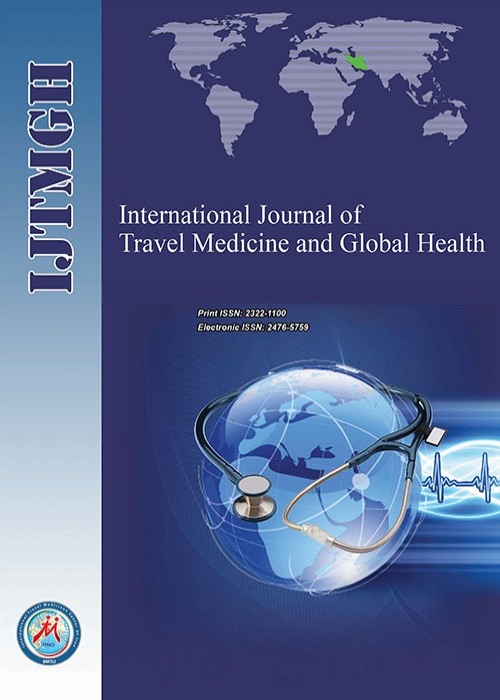فهرست مطالب

International Journal of Travel Medicine and Global Health
Volume:8 Issue: 3, Summer 2020
- تاریخ انتشار: 1399/05/30
- تعداد عناوین: 8
-
-
Pages 91-92
-
Pages 93-95According to the several scientific resources, Iran is considered to be among the melioidosis-endemic regions of the world; this is in stark contrast to the domestic stance in Iran, where the risk of melioidosis is speculated only as an emerging infectious disease in a non-endemic area. Recently, we have had devastating flash floods in the most provinces of Iran; the changing of soil structure may facilitate the cultivation of bacteria in the upper layers of the ground, consequently causes exposure and re-emergence of the disease. Considering previous isolation and identification of Burkholderia mallei, Burkholderia Pseudomallei, and Burkholderia cepacia complex from human, animal, and environment samples in Iran, it is urgently necessary to upgrade and equip infrastructures to identify and distinguish between pathogenic Burkholderia and commensals in the context of the One Health surveillance system. In the present perspective, the history of melioidosis in the country is presented to attract attention to the negligence of disease over the last four decades.Keywords: Burkholderia pseudomallei, Travel Medicine, Sentinel Surveillance
-
Pages 96-99Over the years, the African continent has had to battle several outbreaks of infectious diseases in different countries. Some of the most deadly were the Ebola virus disease (EVD) outbreaks that occurred in West Africa between 2014 and 2016 affecting Guinea, Liberia, and Sierra Leone and, more recently, from 2018 to 2020 in the Democratic Republic of Congo (DRC). In the era of the COVID-19 pandemic, it is important that as a continent, we draw lessons and insights from our past experiences to guide outbreak response strategies being deployed to curb the latest onslaught. The Ebola outbreaks have shown that disease outbreaks should not be seen only as medical emergencies, but as full blown humanitarian crises, because oftentimes, their socio-economic impacts are more devastating than the more obvious cost to life. In this mini-review, we explore the possible humanitarian costs of the COVID-19 pandemic on the African continent by looking through the lens of our past experiences with the EVD outbreaks, highlighting how the current pandemic could significantly affect the African economy, food security, and vulnerable demographics, like children and the sexual and reproductive health and rights of women and girls. We then proffer recommendations that could be instrumental in preventing a double tragedy involving the devastating health consequences of the virus itself and the deadly fallout from its multi-sectoral knock-on effects in African countries.Keywords: COVID-19, SARS-CoV-2, Ebola Virus Disease, Coronavirus
-
Pages 100-106IntroductionTuberculosis (TB) affects vulnerable populations. Immigrants have contributed to the increased incidence of TB. In this population, TB has some common characteristics that can lead to increased resistance to anti-TB drugs and undesired outcomes. In Cartagena de Indias, Colombia, an increase in TB cases has been observed in immigrants. Our objective is to describe the clinical and microbiological characteristics of Mycobacterium tuberculosis in the immigrant population of Cartagena de Indias, Colombia.MethodsA descriptive study of 101 patients with a clinical and microbiological diagnosis of TB was carried out in the city of Cartagena de Indias, Colombia from December 2017 to December 2018. The clinical spectrum and sensitivity profile of M. tuberculosis to first-line anti-TB drugs were characterized by phenotypic tests and molecular markers of resistance. Confidence intervals were calculated for the estimates. Statistical significance was considered at P≤0.05.ResultsA total of 101 patients were analyzed. 8.91% (95% CI: 4.16-16.24%) of the study population were immigrants. Extrapulmonary tuberculosis (EPTB) occurred more frequently among immigrants than in the native population (44.44%; 95% CI 13.70-78.80% vs. 4.49%; 95% CI 1.24-11.11%; P=0.002). The immigrants also had a higher frequency of cases with resistance (15.22 vs. 44.44%; P=0.051) and undesired outcomes, such as therapeutic failure (8.70% vs. 33.33%; P=0.001) and death (4.35% vs. 44.44%; P=0.001).ConclusionImmigrant TB patients were more likely to present particular clinical characteristics, such as HIV coinfection, malnutrition, constitutional manifestations, extrapulmonary spread, the presence of caverns, and undesired outcomes.Keywords: Tuberculosis, Immigrants, Resistance, Anti-Tuberculosis Drugs
-
Pages 107-115IntroductionHigh altitude destinations are popular among international travelers. Travel medicine practitioners should be familiar with altitude physiology and high altitude illness recognition, prophylaxis, and management. We performed the first bibliometric analysis of high altitude medicine research.MethodsAll articles published in a specialist high altitude medicine journal through April 2020 were mapped against the 34 domains in a theoretical body of knowledge. Citation counts of articles, as well as authors publishing the most articles, were obtained from Scopus. Collaboration analysis was performed using established methods.ResultsMapping of 1150 articles published from 2000 to 2020 identified the leading domains represented by high altitude medicine articles. The top five domains were altitude acclimatization and deterioration (19.4%, n=510); cardiovascular physiology (6.8%, n=180); work at altitude (6.6%, n=174); acute mountain sickness (6.4%, n=169); respiratory and acid-base physiology (5.9%, n=155). Published articles attracted a total of 13,324 citations, with a mean of 11.6 citations per article. The average number of citations per author was 22.3. The USA was the most productive country with 432 publications (37.6%), followed by the UK (9.5%, n=109) and Switzerland (5.6%, n=64). The collaboration index for multi-authored publications increased from 3.8 in 2002 to 5.4 in 2019.ConclusionWe have performed the first comprehensive bibliometric analysis in high altitude medicine. Efforts to increase the research activity in neglected topics and to promote greater collaboration between high altitude medicine and related fields of study such as travel medicine may be worthwhile.Keywords: Bibliometric analysis, High Altitude Medicine, Research, Citation analysis, Curriculum Map
-
Pages 116-123IntroductionAlthough education is among the major socioeconomic status (SES) resources that influence populations’ and individuals’ health, social marginalization may reduce the health gain that follows access to SES indicators such as education, a pattern called marginalization-related diminished return (MDR). The literature on MDRs, however, has been mainly derived from studies that have defined marginalization based on race, ethnicity, and sexual orientation. Thus, more research is needed on MDRs that may follow as a result of immigration. To extend what is known on immigration status related MDRs, this study compared a national sample of immigrants and non-immigrants for the effect of education on the poor self-rated health (SRH) of adults in the United States.MethodsWith a cross-sectional design, this study employed data from the 2015 National Health Interview Survey (NHIS), a survey that had enrolled 33,654 adults who were either immigrants (n = 6225; 18.5%) or non-immigrants (n = 27 429; 81.5%). The independent variable was education level, treated as a categorical variable. The dependent variable was poor SRH treated as a dichotomous variable. Race, ethnicity, age, gender, marital status, and region were the confounders. Immigration (nativity) was the moderator. Logistic regression was used for data analysis.ResultsHigher education credentials were associated with better SRH in the pooled sample; however, immigration showed a significant statistical interaction with education level (college graduation) on the outcome. This interaction was indicative of a smaller protective effect of college graduation on poor SRH among immigrants than non-immigrant adults.ConclusionIn line with the MDRs framework, the effect of education on SRH is weaker for immigrants than for non-immigrant adults. There is a need to help highly educated immigrants to mobilize their human capital to secure their best health outcomes, similar to non-immigrants. Such strategies may require bold and innovative policy solutions to reduce discrimination against immigrants, so they can more effectively translate their education and human capital into tangible outcomes such as health.Keywords: Population Groups, Immigration, Immigrants, Nativity, Socioeconomic status, self-rated health
-
Pages 124-130IntroductionRapid public health response is important in controlling the transmission of coronavirus disease 2019 (COVID-19). In this study, we described the public health response received by the Ministry of Health of Malaysia in managing the first local transmission cluster of COVID-19 related to mass-gathering and inter-state traveling to celebrate a festival.MethodsWe summarized strategies implemented by the Malaysia Crisis Preparedness and Response Centre (CPRC) in managing the first local transmission of COVID-19. We collected information related to the epidemiological investigation of this cluster and described the inter-state network in managing the outbreak.ResultsThis first local transmission of COVID-19 in Malaysia had a history of contact with her older brother, the index case, who was the first Malaysian imported case. Only two positive cases were detected out of 59 contacts traced from the index case. Close contacts with infected person/s, inter-state movement, and public/family gatherings were identified as the sources of transmission. A large number of contacts were traced from inter-state traveling, and family gatherings during the festive season, and health consultations and treatment.ConclusionClose contacts from inter-state movement and public/family gatherings were identified as the source of transmission. Family or public gatherings during festivals or religious events should be prohibited or controlled in COVID-19 prevalent areas. A structured surveillance system with rapid contact tracing is significant in controlling the transmission of COVID-19 in the community.Keywords: COVID-19, Travelling, Festival, Malaysia
-
Pages 131-133IntroductionSevere acute respiratory syndrome coronavirus 2 (SARS-CoV-2), or COVID-19, is a pandemic infectious disease involved all over the world. Its mortality, especially in cases with additional co-morbidities, is so high that is has attracted the attention of the world. Diabetes mellitus is known as one of its risk factors for mortality.Case PresentationA unique case of pediatrics COVID-19 who presented with diabetic ketoacidosis (DKA) is reported in this manuscript as the first presentation. He presented with abdominal pain, nausea, and vomiting. RT-PCR test for COVID-19 via nasal swab was performed, and a positive diagnosis was obtained. Chest CT scan confirmed the diagnosis with multifocal bilateral patchy consolidation. Case was discharged after usual treatment of COVID-19.ConclusionIn pediatrics, this disease can be subtle and have a confusion presentation, but it should be controlled to avoid spread of the disease.Keywords: Pediatrics, Coronavirus, Pneumonia, Diabetes Mellitus


